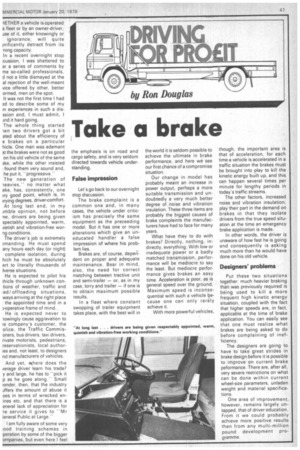Take a brake
Page 49

If you've noticed an error in this article please click here to report it so we can fix it.
the emphasis is on road and cargo safety, and is very seldom directed towards vehicle understanding.
False impression
Let's go back to our overnight stop discussion.
The brake complaint is a common one and, in many cases, the vehicle under criticism has precisely the same equipment as the preceeding model. But it has one or more alterations which give an uneducated handler a false impression of where his problem lies.
Brakes are, of course, dependent on proper and adequate maintenance. Bear in mind, also, the need for correct matching between tractive unit and semi-trailer — or, as in my case, lorry and trailer — if one is to obtain maximum possible results.
In a fleet where constant swopping of trailer equipment takes place, with the best will in the world it is seldom possible to achieve the ultimate in brake performance, and here we see our first chance of a compromise situation.
Our change in model has probably meant an increase in power output, perhaps a more suitable transmission and undoubtedly a very much better degree of noise and vibration insulation. These three items are probably the biggest causes of brake complaints the manufacturers have had to face for many years.
What have they to do with brakes? Directly, nothing, indirectly, everything. With low or inadequate power or a badly matched transmission, performance will be mediocre to say the least. But mediocre performance gives brakes an easy time. Acceleration is poor, as is general speed over the ground. Maximum speed is inconsequential with such a vehicle because one can only rarely achieve it.
With more powerful vehicles, though, the important area is that of acceleration, for each time a vehicle is accelerated in a traffic situation the brakes must be brought into play to kill the kinetic energy built up, and this can happen several times per minute for lengthy periods in today's traffic streams.
The other factors, increased noise and vibration insulation, play their part in the demand on brakes in that they isolate drivers from the true speed situation at the time an emergency brake application is made.
In other words, the driver is unaware of how fast he is going and consequently is asking much more than he would have done on his old vehicle.
Designers' problems
Put these two situations together: much heavier braking than was previously required is being used to kill a more frequent high kinetic energy situation, coupled with the fact that higher speeds are, in fact, applicable at the time of brake application. You can easily see that one must realize what brakes are being asked to do before complaining of inefficiency.
The designers are going to have to take great strides in brake design before it is possible to improve on current brake peformance. There are, after all, very severe restrictions on what can be done within current wheel-size parameters, unladen weight and material specifications.
One area of improvement, however, remains largely untapped, that of driver education. From it we could probably achieve more positive results than from any multi-million pound development programme.
















































































































